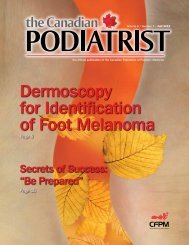Disinfection and Sterilization in the Chiropody Office
Disinfection and Sterilization in the Chiropody Office
Disinfection and Sterilization in the Chiropody Office
You also want an ePaper? Increase the reach of your titles
YUMPU automatically turns print PDFs into web optimized ePapers that Google loves.
2<br />
<strong>Dis<strong>in</strong>fection</strong> of <strong>the</strong> Healthcare Equipment<br />
There are many dis<strong>in</strong>fection of environmental surfaces <strong>in</strong> health-care facilities readily available<br />
through our medical suppliers. Many of <strong>the</strong>se dis<strong>in</strong>fectants have a contact time of 30-60<br />
seconds which have significant microbial reduction. Consult your medical supplier for a<br />
registered or government approved product <strong>and</strong> confirm <strong>the</strong> usage, storage <strong>and</strong> shelf life of<br />
<strong>the</strong>se products.<br />
Factors affect<strong>in</strong>g <strong>the</strong> Efficacy of <strong>Dis<strong>in</strong>fection</strong> & <strong>Sterilization</strong><br />
Physical location & Cross contam<strong>in</strong>ation (efficient <strong>in</strong>strument process<strong>in</strong>g, separate<br />
clean<strong>in</strong>g, sterilization <strong>and</strong> storage. Workflow direction elim<strong>in</strong>ates <strong>the</strong> risk of crosscontam<strong>in</strong>ation)<br />
Duration of exposure (appropriate m<strong>in</strong>imum contact time)<br />
Concentration of Dis<strong>in</strong>fectants (solutions improperly measured/mixed)<br />
Physical & Chemical Factors (temperature, water hardness, relative humidity, PH)<br />
Organic & Inorganic Matter (where all <strong>the</strong> <strong>in</strong>struments properly<br />
manually/mechanically cleaned)<br />
<strong>Dis<strong>in</strong>fection</strong> & <strong>Sterilization</strong><br />
1. Pre-clean<strong>in</strong>g<br />
Immediately after use, r<strong>in</strong>se <strong>in</strong>struments under warm runn<strong>in</strong>g water. R<strong>in</strong>s<strong>in</strong>g should remove<br />
most of <strong>the</strong> blood, body fluids <strong>and</strong> tissue.<br />
2. Clean<strong>in</strong>g<br />
Spray a non aerosol, dual enzyme foam to loosen <strong>and</strong> breakdown any rema<strong>in</strong><strong>in</strong>g blood <strong>and</strong><br />
debris.<br />
A. Manual Clean<strong>in</strong>g (prior to ultrasonic clean<strong>in</strong>g)<br />
I. Put on mask, eye protection <strong>and</strong> gloves (puncture proof utility gloves as an over-glove may be<br />
added) Personal protective equipment should be worn when scrubb<strong>in</strong>g <strong>in</strong>struments.<br />
Instruments should also be submerged under water when be<strong>in</strong>g cleaned to m<strong>in</strong>imize aerosols.<br />
II. Use a stiff plastic nylon clean<strong>in</strong>g brush. Do not use steel wool or wire brushes as <strong>the</strong>y may<br />
damage <strong>the</strong> <strong>in</strong>struments.<br />
III. Use neutral pH (7) cleaners. Lower of higher pH detergents cause surface sta<strong>in</strong><strong>in</strong>g of brown<br />
<strong>and</strong> black deposits which <strong>in</strong>terfere with <strong>the</strong> smooth operation of <strong>the</strong> <strong>in</strong>strument by break<strong>in</strong>g<br />
down <strong>the</strong> sta<strong>in</strong>less protective surface.<br />
IV. Brush <strong>in</strong>struments carefully <strong>and</strong> h<strong>and</strong>les <strong>the</strong>m totally separate from general <strong>in</strong>struments.<br />
V. Make sure all <strong>in</strong>strument surfaces are visibly clean <strong>and</strong> free from sta<strong>in</strong>s <strong>and</strong> tissue. While<br />
r<strong>in</strong>s<strong>in</strong>g, open <strong>and</strong> close scissors, hemostats <strong>and</strong> o<strong>the</strong>r h<strong>in</strong>ged <strong>in</strong>struments to make sure <strong>the</strong><br />
h<strong>in</strong>ge areas are r<strong>in</strong>sed out, as well as <strong>the</strong> surface of <strong>the</strong> <strong>in</strong>struments.<br />
B. Ultrasonic Clean<strong>in</strong>g<br />
Instruments should be processed <strong>in</strong> <strong>the</strong> cleaner for <strong>the</strong> full recommended cycle time – usually 5<br />
to 10 m<strong>in</strong>utes. Use a multipurpose concentrated <strong>in</strong>strument cleaner (Metriclean 2). Place<br />
<strong>in</strong>struments <strong>in</strong> open position <strong>in</strong>to <strong>the</strong> ultrasonic cleaner. Make sure that “Sharps” (scissors,<br />
knives, etc.) blades do not touch o<strong>the</strong>r <strong>in</strong>struments. All <strong>in</strong>struments must be fully submerged.<br />
Do not place differ<strong>in</strong>g metals (sta<strong>in</strong>less, copper, chrome-plated, etc.) <strong>in</strong> <strong>the</strong> same clean<strong>in</strong>g cycle.
















